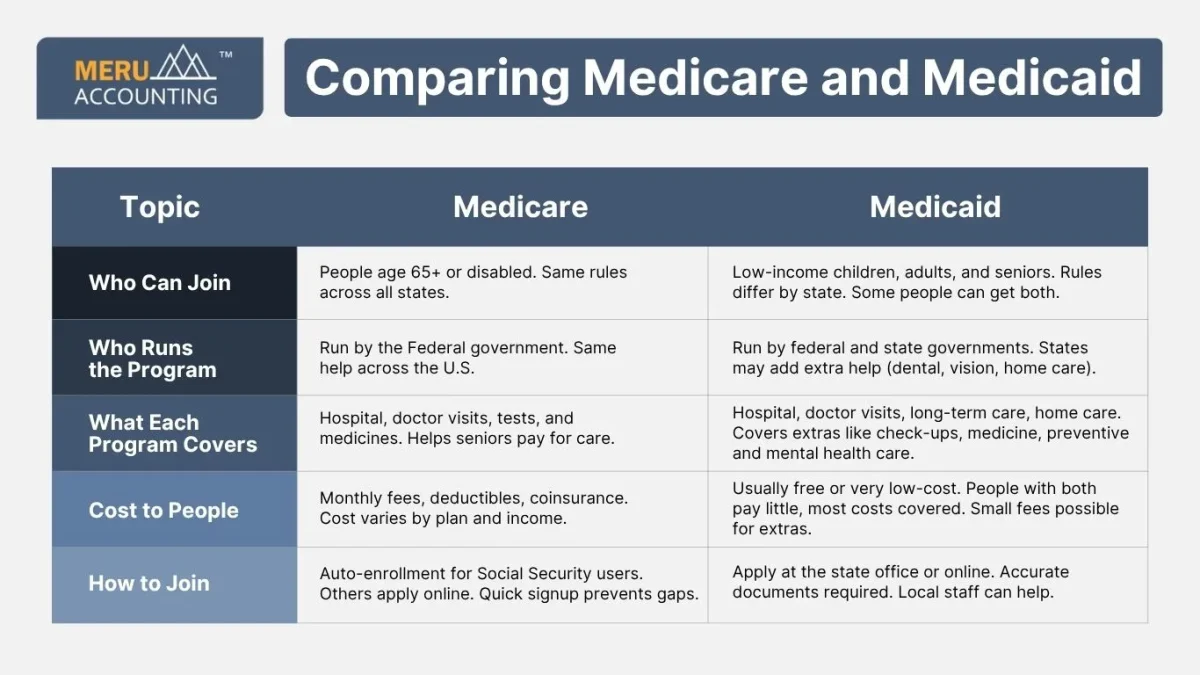Understanding the Difference Between Medicare and Medicaid Programs
Healthcare in the U.S. can be hard to understand. Knowing the difference between Medicare and Medicaid helps people make smart choices. Both programs help pay for health care, but they serve different people. Medicare mainly helps older adults and some disabled adults. Medicaid helps low-income families, children, and seniors who need help. Knowing the rules for each program makes planning easier.
Some people qualify for both Medicare and Medicaid. Learning how each program works can save money. It also ensures people get the care they need. This guide explains who can get each program, what services are included, and how to apply.
What Is Medicare?
Medicare is health help from the federal government. It helps people age 65 or older. Some younger people with disabilities also qualify. Medicare helps pay for hospitals, doctors, and medicine. It reduces the money people spend on care.
Who Can Get Medicare
- Seniors age 65 or older: All U.S. citizens or residents can join. They get help for hospital and doctor care.
- Younger people with disabilities: Must meet Social Security rules. They get hospital, doctor, and medicine help.
- People with certain illnesses, Kidney failure or ALS, may qualify. They get extra help for treatment.
- People on Social Security: Can join automatically at age 65. This gives care before serious health problems start.
- Family care planning: Some family members may get extra help. This covers care costs and medicines.
Parts of Medicare
- Part A – Hospital Help
Covers hospital stays, nursing, and hospice care. Also pays for some home care. Helps reduce large hospital bills for seniors. - Part B – Doctor Help
Covers doctor visits, tests, and outpatient care. Includes some medical tools and therapy. Helps seniors pay for routine and urgent care. - Part C – Medicare Advantage
Private plans approved by Medicare. Includes all benefits from Parts A and B. May give extra help like dental or vision. Offers more choice of doctors and hospitals. Some plans include wellness programs for better health. - Part D – Medicine Help
Helps pay for prescription drugs at pharmacies. Plans differ by cost and drugs covered. Helps seniors afford needed medicine and manage illnesses. Some plans cover high-cost drugs, too.
Costs of Medicare
- Monthly fees: Paid for Part B or D. Fees vary by plan and income.
- Deductibles: Money paid before Medicare helps. Deductibles reset every year.
- Coinsurance: A Small share of costs the person pays. Helps share costs between Medicare and the person.
- Extra costs: Some services may not be fully paid for. Planning money helps avoid surprises.
- Tips: Choosing the right plan saves money long-term. Compare yearly to find the best choice.
How to Join Medicare
- Automatic enrollment for Social Security users at 65. Ensures no gap in health help.
- Others can apply online or at Social Security offices. Staff can give help if needed.
- Special periods allow changes if the first signup was missed. Prevents penalties and extra costs.
- Late signup may cost more money.
- Use comparison tools to pick the best plan. Tools show cost, benefits, and choices clearly.
What Is Medicaid?
Medicaid gives health care to low-income people. It is run by states with federal support. Each state sets some rules and extra help. Medicaid helps families, children, seniors, and people with disabilities. Some states offer more services than others.
Who Can Get Medicaid
- Low-income families and children can join. Covers doctor visits, hospitals, and medicine.
- Pregnant women often get full care. Helps ensure healthy pregnancies and babies.
- Older adults and disabled people may join. Pays for nursing or home help.
- States may expand to cover more people. Helps adults without children or jobs.
- Emergency and preventive care are often included. Vaccines and check-ups help prevent bigger problems.
Services Medicaid Covers
- Hospital Help: Stay in or out. Helps poor people avoid big bills. Gives peace as costs will not pile up.
- Doctor Visits: Check-ups and visits. Makes sure people get care fast. Keeps health safe with quick doctor advice.
- Lab Tests and X-rays: Blood tests and scans. Used to find and treat health issues. Doctors act fast once the test shows a sign.
- Nursing or Long-Term Care: Homes or home help. Helps old people live safely with care. Staff give help with food, meds, and needs.
- Home Services: Care at home or centers. Keeps people out of the hospital. Gives comfort as care is near and close.
- Check-Ups and Shots: Exams and shots. Helps find health issues at the start. Stops big health risks with small early steps.
- Mental Health: Talk and support. Helps deal with stress, worry, and a sad mood. Gives hope so life feels light and bright.
- Dental Care: Some states pay for teeth care. Helps keep the mouth and gums clean. Stops pain and helps keep a strong smile.
- Vision and Hearing: Eye and ear tests. Some states give help with glasses and aids. Lets people live a full life with a clear sense.
- Medicines: Some states pay for drugs not in Medicare. Helps poor people get needed drugs. Makes sure care does not stop due to cost.
Costs of Medicaid
- Usually free or very low-cost for eligible people. Helps people get care without high bills.
- Some states charge small fees. Payments are small and easy for low-income families.
- Costs depend on state rules and the money people earn. Extra help may lower costs.
- Helps avoid large bills. Makes care easier and safer.
- Some extra help is available. Includes transport to appointments or extra medicine.
How to Join Medicaid
- Apply at the state office or online portal. Websites have step-by-step help.
- Show income, address, and family details. Documents must be correct to avoid delay.
- States approve applications and start care once eligible. Some process fast, some slower.
- Complete applications reduce delays. Incomplete forms may take longer to approve.
- Help is available. Local offices or nonprofits can guide applicants.
Comparing Medicare and Medicaid
Topic | Medicare | Medicaid |
Who Can Join | People age 65+ or disabled. Same rules across all states. | Low-income children, adults, and seniors. Rules differ by state. Some people can get both. |
Who Runs the Program | Run by the Federal government. Same help across the U.S. | Run by federal and state governments. States may add extra help (dental, vision, home care). |
What Each Program Covers | Hospital, doctor visits, tests, and medicines. Helps seniors pay for care. | Hospital, doctor visits, long-term care, home care. Covers extras like check-ups, medicine, preventive and mental health care. |
Cost to People | Monthly fees, deductibles, coinsurance. Cost varies by plan and income. | Usually free or very low-cost. People with both pay little, most costs covered. Small fees possible for extras. |
How to Join | Auto-enrollment for Social Security users. Others apply online. Quick signup prevents gaps. | Apply at the state office or online. Accurate documents required. Local staff can help. |

Can You Have Both?
Both Programs Together
- Some people meet the rules for both programs. Helps seniors and low-income disabled adults.
- Both programs together provide better care and lower costs. Reduces money spent.
- Coverage includes hospital, doctor, medicine, and home help. Supports seniors and disabled people.
Why Both Help
- Medicaid pays what Medicare does not. Covers fees and extra costs.
- Lowers premiums, deductibles, and coinsurance. Saves money for people.
- Helps manage hospital, doctor, and medicine costs. Makes health care more affordable.
- Offers home help and long-term care. Improves quality of life.
How They Work Together
- Medicare pays first. Medicaid pays what is left.
- Ensures full care for the hospital, doctor, and medicine. Reduces money stress.
- Cuts out-of-pocket costs for people. Let’s people focus on health.
How to Apply
Medicare
- Automatic for Social Security users at 65. Ensures care starts on time.
- Others can apply online or in the office. Staff can give help.
- Open Enrollment allows yearly changes. Avoid penalties by signing on time.
- Late signup may cost more. Plan early to save money.
- Use tools to compare plans. Shows cost, benefits, and choices.
Medicaid
- Apply at the state office or online portal. Websites give step-by-step help.
- Show income, address, and family details. Must be accurate to get approval.
- States approve based on rules. Coverage starts when accepted.
- Complete forms to avoid delay. Incomplete forms take longer to approve.
- Help is available. Nonprofits and local offices can guide applicants.
Understanding the difference between Medicare and Medicaid helps people make smart choices. Medicare serves older adults and some disabled adults. Medicaid serves low-income families, children, and seniors. Some people can get both programs for better care and lower costs. Planning ahead reduces stress and saves money.
Meru Accounting helps clinics manage money and records. We helps in reducing errors and save time. Our services include budget help and cash flow tracking. Meru Accounting ensures businesses work well and stay safe.
FAQs
- Can I get both Medicare and Medicaid?
Yes, if you meet the rules for both programs. Coverage is better with both. - Does Medicare cover long-term care?
No, it covers only short-term care. Medicaid helps with long-term needs. - Is Medicaid the same in all states?
No, states set rules and benefits. Some states offer more help. - Do I pay for Medicare?
Yes, some parts need monthly fees. Cost may change with income. - How do I join Medicaid?
Apply at the state office or online. Provide the correct documents for faster approval. - Can I change my Medicare plan?
Yes, during Open Enrollment each year. Helps get better care. - Does Medicaid cover dental care?
It depends on state rules. Some states cover adults and children.








